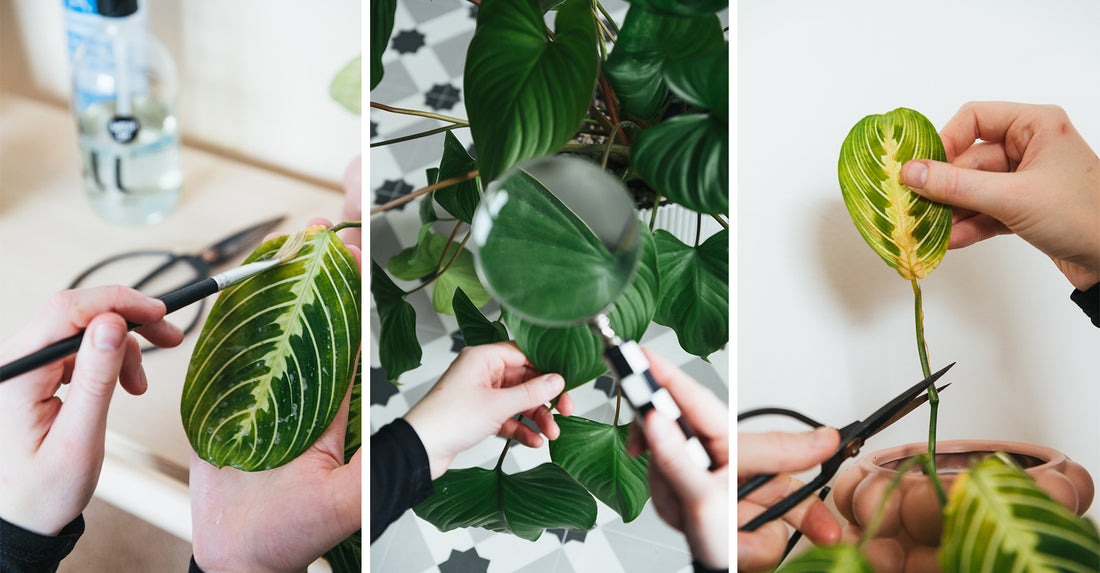When your plant has pests, unfortunately it’s unlikely to be a one off treatment. You may have to repeat treatments a fair few times depending on the plant and situation.
We recommend trying to create a routine check when tending/watering your plants to help you spot any pests before a major breakout. This involves checking the backs of the leaves and using a magnifying glass to look into the nooks and crannies. If you spot any pests whilst running these checks, it's your cue to isolate your infected plant/plants. If you have a bathtub, that’s the perfect spot to treat it.
Once you're confident you have ‘the all clear’ from any pests, we recommend investing in some predatory bugs from @Dragonfli, or any integrated pest management supplier, as this will help to prevent any more outbreaks and may very well prevent any missed or fragmented small populations of pests returning immediately after you stop directly treating your plants. Allow for at least two weeks after treatment before using any type of beneficial bugs.
We understand that some people prefer using pesticides or Neem oil in order to get rid of these menaces, but we would recommend at first using less intensive measures in order to eliminate any pests. Pesticides and Neem oil can be used incorrectly and can even cause harm to foliage, root structure and other issues.
With most pests, the eggs can be hard to remove – so if your plant has badly damaged leaves, we recommend cutting them off with a pair of sterilised scissors. The likelihood of that leaf having eggs on them is high, so discarding those leaves will help to break the cycle.
For our recommended methods, you may want to make sure you have these tools to hand:
- A Small Brush (an old make-up brush or paint brush)
- An Old Tooth Brush
- Sticky Traps (Yellow & Blue)
- A Spray Bottle
- Rubbing Alcohol (Around 70%)
- Hydrogen Peroxide (3-5%)
- Unscented/Plant-Based Dish Soap.
- And Persistence!
Let’s get down to the nitty gritty…
Mealy Bugs:
For these fluffy little freaks you’ll need to make a mixture using 4 parts water, 1 part Rubbing Alcohol and a few drops of unscented dish soap in a dish or bowl – give it a good mix and get brushing all those mealies away! You’ll want to brush the infected plant completely down making sure you get into all the crevices. Feel free to use this mixture in a spray bottle and spray the plant down and this solution can also be used to combat root mealies by flushing the affected plant through, allowing it to sit for 20-30 minutes and then flushing again with fresh water.
Repeat once a week until you’re confident all life stages have been eliminated. You can also store this solution and use it to 'spot treat' small outbreaks long after your main treatment regime.
Keep your plants isolated until you're confident they have all gone.
Thrips:
Isolate any infected plants in another room away from your collection ASAP. Cover the base of your plant with a bin liner and rinse the plant down completely – this will protect the substrate from getting wet, as you don’t want to over water your plant. If you have a strong setting on your shower head, the pressure can help to wash them away. If you can, remove the top few inches of soil and replace with fresh soil, that will stop any fallen thrips getting back up onto your plant.
Time to make a little concoction using 4 parts water, 1 part Rubbing Alcohol and a few drops of unscented dish soap in a spray bottle. Spray the plant down and wipe down the leaves with a brush (front, back, petioles etc). Spray the plant again and leave the plant for a few days.
Whilst the affected plants are isolated, use sticky traps to catch any adults from flying away (use blue if possible) – the fact Thrips have asexual reproduction and can fly, that’s what makes these little buggers such a pain to get rid of.
Repeat treatment once a week until you are confident all Thrip life stages have been eliminated.
Scale:
Soak a toothbrush in a dish of Rubbing Alcohol – Gently brush the scale in circular motions to try and loosen the Scales grip onto the leaf. If the scale isn’t coming off, use your nail or butter knife to try and scrape it off.
Re-treat your plant 1-3 times before placing it back into your collection. This will ensure all life stages have been terminated.
Spider Mites:
This is a similar method to treating Mealy Bugs - Using 4 parts water, 1 part Rubbing Alcohol and a few drops of unscented dish soap – give it a good mix and brush your plant down from top to bottom.
Repeat this treatment intensively every couple days for a few weeks until you are confident they are gone.
Fungus Gnats:
There are a few ways to prevent Fungus gnats, like bottom watering your plants, sticky pads, using a top layer etc. But if you have a bad infestation this is how to treat it!
We recommend using Hydrogen Peroxide to kill the eggs and larvae – this will break their lifecycle. Using Sticky Pads alongside this will catch any adults looking to start the cycle again.
Simply pour Hydrogen Peroxide 3-5% into the soil until it is fully saturated and let it bubble away. This treatment should be more than enough to get rid of the early life stages!
-
On a final note, it’s essential to remember that pests can never truly be eradicated, no matter how much effort we put into managing them. They can exist in our homes, gardens, and even on the underside of a seemingly healthy plant. They can come from anywhere, including through open windows or doors, or even on our clothes. As a result, it's crucial to comprehend the relationship between plants and pests when maintaining a large botanical collection. This understanding will enable you to keep your green babies looking beautiful and healthy, ensuring the longevity of your plant collection.

